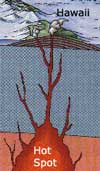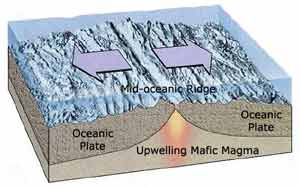THE NATURAL ENVIRONMENT
Geography 101
ToC
MOUNTAINS
Crust
Folding
Earthquakes
Volcanoes
Hawai'i
Volcanoes
|
|
BOX 1 |
Volcanism is the most obvious endogenic expression of Earth's internal heat. Magma rises to the surface and hardens into new crustal rock. Unlike folding, which produces mountains and valleys out of existing hard rock, volcanism can produce mountains, plateaus, and other landforms by creating new material.
The characteristics of landforms created by volcanism depend on the type of magma involved and the manner in which it is expelled onto the surface. Particularly important is the distinction between mafic and felsic magma (see Chapter 9 -> Interior). They produce very different kinds of eruptions.
Effusive Eruptions
MAGMA COMPARISON |
||
Property |
Mafic Magma |
Felsic Magma |
Composition |
iron, magnesium |
silica, aluminum |
Color |
darker |
lighter |
Density |
higher (3 g/cm3) |
lower (2.7 g/cm3) |
Viscosity |
lower |
higher |
Formation Temp. |
higher |
lower |
Example of Rock |
basalt |
granite |
Eruption Type |
effusive |
explosive |
Location |
hot spots, mid-oceanic ridges |
subduction zones |
The adjacent Magma Comparison table summarizes properties of the two basic magma
types. Mafic magma produces high volume, slow
moving, effusive eruptions. It forms within the upper mantle, much deeper
than
felsic magma. Because of the depth, it is hotter and contains more high
density materials, such as iron and magnesium.  These
differences cause
lower viscosity (more "runny") and darker color than felsic magma.
These
differences cause
lower viscosity (more "runny") and darker color than felsic magma.
 Mafic
magma erupts gently, seldom producing explosions unless it mixes with
enough water to cause steam explosions. These eruptions
can deposit an enormous amount of lava onto the surface and may continue
over long periods. Kilauea on the Big Island, for example, has erupted
mafic lava almost continuously since 1983.
Mafic
magma erupts gently, seldom producing explosions unless it mixes with
enough water to cause steam explosions. These eruptions
can deposit an enormous amount of lava onto the surface and may continue
over long periods. Kilauea on the Big Island, for example, has erupted
mafic lava almost continuously since 1983.  Because
the viscosity is low, mafic magma tends to produce volcanic cones with
gentle slopes, called
shield volcanoes. These enormous structures form the
largest (in volume and mass) mountains on Earth. Typically, they contain
a summit
caldera, or large central crater, caused by
repeated advances and retreats of the magma source.
Because
the viscosity is low, mafic magma tends to produce volcanic cones with
gentle slopes, called
shield volcanoes. These enormous structures form the
largest (in volume and mass) mountains on Earth. Typically, they contain
a summit
caldera, or large central crater, caused by
repeated advances and retreats of the magma source.
 Effusive eruptions commonly occur at hot spots, like Hawai'i
and Iceland, and at areas of sea-floor
spreading.
At the latter locations, mafic magma originates in the upper mantle and rises
into the breach caused by diverging lithospheric plates. The resulting underwater
eruptions produce long linear, basaltic mountain ranges and large areas
covered with lava called flood basalts.
Effusive eruptions commonly occur at hot spots, like Hawai'i
and Iceland, and at areas of sea-floor
spreading.
At the latter locations, mafic magma originates in the upper mantle and rises
into the breach caused by diverging lithospheric plates. The resulting underwater
eruptions produce long linear, basaltic mountain ranges and large areas
covered with lava called flood basalts.
Flood basalts also occur on continents. Mafic lava spills out of cracks in the lithosphere caused by tectonic forces and coats large areas with layer upon layer of hardened basalt. Examples are the Columbia River Basin in Washington state and the Deccan Plateau in India.
Explosive Eruptions
 If
you ask someone to describe a volcanic eruption, they are not likely
to talk about shield volcanoes and flood basalts. They
will probably describe great explosions and towering ash clouds. The
volcanoes that produce this kind of eruption are powered by felsic
magma.
Felsic magma forms at lower temperatures and has a different chemical composition
than mafic magma (see table above for comparison). The lower temperature of formation reflects a shallower origin near the base of the lithosphere.
If
you ask someone to describe a volcanic eruption, they are not likely
to talk about shield volcanoes and flood basalts. They
will probably describe great explosions and towering ash clouds. The
volcanoes that produce this kind of eruption are powered by felsic
magma.
Felsic magma forms at lower temperatures and has a different chemical composition
than mafic magma (see table above for comparison). The lower temperature of formation reflects a shallower origin near the base of the lithosphere.

At plate collision boundaries with subduction, partial melting takes place at the upper surface of the subducting plate, as shown in the diagram. This produces rising conduits of high-viscosity felsic magma. This molten plume may breach the surface explosively in coastal mountain ranges or island arcs. Examples include the Andes Mountains of South America, Cascade Range in North America, and the Japan Islands in the western Pacific.
 Because
if its relatively high viscosity, felsic magma is resistant
to flow and tends to plug volcanic
vents, causing a buildup of pressure that may release violently. This
resistance to flow also produces steep sided, symmetric volcanic cones
called composite
volcanoes.
They form some of the most esthetically beautiful mountains in the world,
including
Mt. Misti in the Peruvian Andes shown in the image. Beauty belies
danger though, as the lovely cone will inevitably vaporize in
a thunderous explosion, as Mt. St. Helens did in 1983. Composite volcanoes are much smaller in
volume than shield volcanoes, as illustrated
in the comparison of Mauna Loa, the largest mountain on Earth, and Mt.
Rainier in Washington state.
Because
if its relatively high viscosity, felsic magma is resistant
to flow and tends to plug volcanic
vents, causing a buildup of pressure that may release violently. This
resistance to flow also produces steep sided, symmetric volcanic cones
called composite
volcanoes.
They form some of the most esthetically beautiful mountains in the world,
including
Mt. Misti in the Peruvian Andes shown in the image. Beauty belies
danger though, as the lovely cone will inevitably vaporize in
a thunderous explosion, as Mt. St. Helens did in 1983. Composite volcanoes are much smaller in
volume than shield volcanoes, as illustrated
in the comparison of Mauna Loa, the largest mountain on Earth, and Mt.
Rainier in Washington state.

This type of volcanism occurs along subduction zones at
continental margins. The series of mountains running from the southern
tip of Chile to Alaska in North America is due to continental
crust-oceanic crust collision and the resultant folding and
volcanism.
Another type of collision also produces explosive eruptions. When two plates topped with oceanic crust collide, one will be forced to subduct below the other and the same partial melting process takes place.
The rising plume of felsic magma emerges offshore from the continental land mass and forms a volcanic island arc. Prominent examples of this type of explosive island group include Japan, the Philippines, and the main islands of Indonesia.